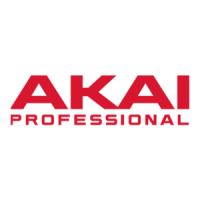
Do you have a question about the Akai EWI Series and is the answer not in the manual?
| Type | Electronic Wind Instrument |
|---|---|
| Connectivity | USB, MIDI |
| Power | Battery |
| Controls | Breath sensor, octave rollers |
| Sound Engine | Built-in sound engine |
| Polyphony | 128 voices |
| Sensors | Breath, bite, finger |
| Power Source | Batteries |
Details power supply requirements and how to set the voltage selector for different regions.
Provides essential safety precautions for users and the Akai EWV2000 to prevent electric shock and damage.
Important cautions regarding electrical hazards, opening the unit, and battery replacement.
Detailed explanation of each knob, button, and display element on the EWV2000's front panel.
Describes the function of the TAPE IN/OUT jacks, MEMORY PROTECT switch, MIDI OUT, and POWER INLET.
Step-by-step guide for saving the factory-preset voice data onto a cassette tape.
Details parameters for the first oscillator, including frequency, waveform, pulse width, and modulation.
Explains EXT BALANCE, CUTOFF FREQ, and RESONANCE for the first VCF.
Covers OSC WAVE FM, PITCH FOLLOWER, HI-PASS-FIL, and VCF EG parameters for Source 1.
Details VCF EG SUSTAIN, RELEASE, DEPTH, and VCA EG ATTACK parameters for Source 1.
Covers VCA EG DECAY, SUSTAIN, RELEASE, DEPTH, SOURCE-1 OUT LEVEL, and VIB VCO parameters.
Details VIB PWM, VCF, VCA, BEND WIDTH, and BREATH control parameters for Source 1.
Explains creating sounds using breath envelopes, controlling VCF, resonance, volume, and pitch.
Guide to creating sounds using VCF and VCA envelope generators, similar to analog synthesizers.
Steps for creating sounds using the EG for Source 2, isolating its output.
Guide on saving created voices into the 64 memory banks using the WRITE button.
Instructions for programming polyphonic chord patterns, including range and examples.
Assigning specific program numbers to key notes to trigger programmed chord patterns.
